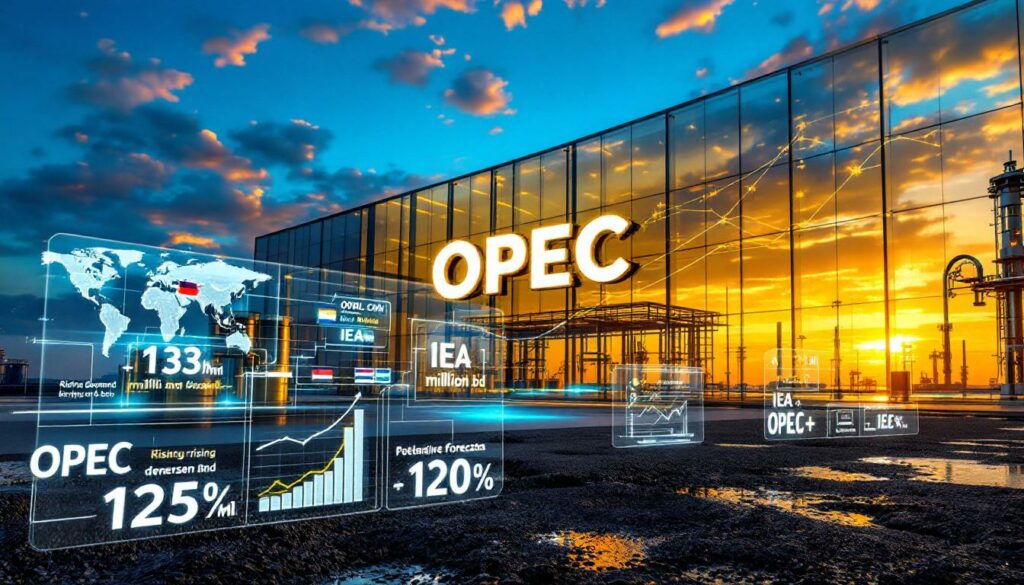Understanding OPEC's Role in the Global Oil Market
OPEC's influence on global oil markets extends far beyond simple supply management. As an organization controlling approximately 80% of the world's proven oil reserves, OPEC wields extraordinary power in shaping energy markets, economic policies, and geopolitical relationships worldwide.
The group's decisions ripple through the global economy, affecting everything from inflation rates to transportation costs. Through strategic production quotas and output adjustments, OPEC member states collectively influence price stability while pursuing their individual national interests within the cooperative framework.
OPEC's market power has evolved significantly since its founding in 1960, adapting to changing market dynamics including the rise of U.S. shale production, renewable energy adoption, and shifting oil price movements. Despite these challenges, the organization maintains substantial leverage in determining global oil market conditions.
What Is OPEC and How Does It Function?
OPEC's Structure and Membership
The Organization of Petroleum Exporting Countries comprises 13 member nations that collectively possess approximately 80% of the world's proven oil reserves. These nations coordinate their petroleum policies through a secretariat headquartered in Vienna, Austria, where ministerial meetings determine production policies and market strategies.
Member countries include Saudi Arabia, Iran, Iraq, Kuwait, Venezuela, Qatar, Libya, United Arab Emirates, Algeria, Nigeria, Ecuador, Gabon, and Angola. Each member holds voting power within the organization, though Saudi Arabia, with its outsized production capacity, often functions as the de facto leader.
The organization operates through a structured governance system with a Secretary General (currently Haitham Al Ghais) who oversees administrative functions and represents OPEC in global forums. Decision-making occurs primarily through consensus during biannual ministerial conferences, with extraordinary meetings called during market disruptions.
OPEC+ and Extended Influence
Since 2016, OPEC has significantly expanded its market coordination through the OPEC+ alliance, which includes non-OPEC producers like Russia, Kazakhstan, and Mexico. This expanded coalition controls approximately 55% of global oil production, dramatically enhancing the group's ability to influence market conditions.
The OPEC+ framework emerged following the 2014-2016 oil price collapse, when producers recognized the need for broader coordination to stabilize markets. The alliance has demonstrated remarkable cohesion despite occasional internal tensions, implementing historic production cuts during market downturns and methodically restoring output during recovery periods.
In July 2025, OPEC demonstrated its control over market information by barring five media outlets from its Vienna meeting, highlighting the organization's influence extends beyond production policies to shaping market narratives and information flows.
How Does OPEC Project Future Oil Demand?
OPEC's World Oil Outlook Methodology
OPEC's demand forecasting employs sophisticated economic modeling that incorporates multiple variables:
- Global GDP growth projections across developed and emerging economies
- Population trends and demographic shifts, particularly urbanization rates
- Transportation sector evolution, including vehicle fleet growth and fuel efficiency
- Industrial development patterns across regions and energy-intensive sectors
- Energy efficiency improvements and technological adoption rates
- Policy changes and regulatory frameworks affecting consumption patterns
This comprehensive approach allows OPEC to develop long-term projections that account for both macroeconomic trends and sector-specific developments. The organization typically publishes these forecasts in its annual World Oil Outlook (WOO), which serves as a benchmark for industry planning.
Key Findings from OPEC's Latest Outlook
OPEC's most recent World Oil Outlook projects global oil demand will grow approximately 19% from current levels to reach 123 million barrels per day (bpd) by 2050. As Secretary General Haitham Al Ghais emphatically stated, "There is no peak oil demand on the horizon."
This forecast contrasts sharply with other industry projections, particularly those from the International Energy Agency (IEA), which anticipates demand plateauing around 105.5 million bpd by 2030 before declining.
OPEC has recently revised its demand growth projections for 2025-2029 downward, primarily due to slowing Chinese consumption. This adjustment demonstrates the organization's ongoing refinement of its forecasting models in response to changing market conditions.
| Organization | 2050 Oil Demand Forecast | Peak Oil Demand View |
|---|---|---|
| OPEC | 123 million bpd | No peak in sight |
| IEA | Decline after 2030 | Around 2030 |
| Major Oil Companies | Varies (100-110 million bpd) | Mid-2030s |
Why Does OPEC Reject Peak Oil Demand Theories?
Economic Development as a Demand Driver
OPEC's optimistic demand outlook stems from its assessment of strong growth in developing economies:
- India leads the charge: Projected to increase oil consumption by 8.2 million bpd between 2025 and 2050, representing the single largest growth market
- Middle East and African nations will drive approximately 38% of global demand growth
- Expanding middle class populations in emerging economies will increase energy-intensive consumption patterns
- Industrial development in these regions requires affordable, reliable energy sources
OPEC analysts point to historical patterns showing that as countries develop economically, their per-capita energy consumption increases substantially before eventually plateauing. With billions of people still entering middle-class status across developing regions, OPEC sees substantial growth runway for petroleum products.
Geopolitical Factors Supporting Continued Demand
OPEC cites several geopolitical developments supporting its bullish outlook:
"The US withdrawal from the Paris Agreement will […] result in higher demand for hydrocarbons."
– OPEC World Oil Outlook 2025
Additional factors include:
- Persistent fossil fuel subsidies in many developing economies making alternatives less competitive
- Challenges in scaling renewable infrastructure globally, with the EU facing a €250 billion grid investment gap
- Strategic energy security concerns maintaining oil's relevance in national planning
- Political resistance to rapid transitions that might disrupt employment and economic stability
These combined factors lead OPEC to project continued demand growth well into mid-century, with no peak in sight.
How Do OPEC's Forecasts Compare to Other Market Perspectives?
Contrasting Views on Future Demand
The stark divergence between OPEC's projections and those from other energy authorities highlights fundamental differences in assumptions about:
- Electric vehicle adoption rates: OPEC projects slower EV penetration compared to IEA and BloombergNEF forecasts
- Renewable energy cost trajectories: OPEC anticipates more moderate cost declines than clean energy advocates
- Policy implementation effectiveness: OPEC questions whether ambitious climate policies will be fully implemented
- Economic growth patterns: OPEC emphasizes continued hydrocarbon-intensive development in emerging markets
These differing assumptions create dramatically different conclusions about oil's future. While OPEC sees demand reaching 123 million bpd by 2050, the IEA's Oil 2025 report projects a plateau around 105.5 million bpd by 2030 followed by decline.
Market Implications of Competing Forecasts
These contrasting outlooks create significant uncertainty for:
- Long-term investment decisions: Companies must hedge between competing demand scenarios
- National energy planning: Producer nations face difficult choices about infrastructure development
- Climate policy development: Regulatory frameworks must address the potential for both scenarios
- Financial markets: Asset valuations reflect the tension between these competing visions
Investment strategies increasingly incorporate scenario planning that accounts for both continued growth and potential demand peaks, with risk management strategies designed to navigate the uncertainty between OPEC's bullish outlook and more conservative projections.
What Factors Could Change OPEC's Demand Projections?
Technological Disruptions
Several technological developments could challenge OPEC's bullish demand outlook:
- Battery technology breakthroughs: Next-generation solid-state batteries could accelerate EV adoption
- Hydrogen fuel advancement: Green hydrogen production costs are declining more rapidly than expected
- Industrial electrification: Novel processes for cement, steel, and chemical production could reduce industrial oil demand
- Carbon capture cost reductions: Making continued fossil fuel use more climate-compatible
The pace of innovation represents a key uncertainty in OPEC's projections. While the organization acknowledges these technologies, it generally assumes more gradual adoption curves than clean energy advocates project.
Policy and Regulatory Evolution
Changes in the global regulatory landscape could significantly impact demand trajectories:
- Carbon pricing mechanisms: Expanding beyond current markets and increasing in stringency
- Fossil fuel subsidy reforms: Particularly impactful if implemented in developing economies
- Vehicle efficiency standards: Accelerating fuel economy improvements in conventional vehicles
- Renewable energy mandates: Pushing more rapid electricity decarbonization
Policy implementation remains a significant uncertainty, with OPEC highlighting the gap between announced ambitions and actual implementation. The EU's challenge in funding its €250 billion grid investment gap exemplifies the practical hurdles in energy transition challenges.
How Does OPEC Respond to Changing Market Conditions?
Production Adjustment Mechanisms
OPEC maintains market influence through several strategic mechanisms:
- Coordinated production cuts: Implemented during oversupply periods to stabilize prices
- Strategic capacity expansion: Developed during tight market conditions to prevent price spikes
- Quota allocation systems: Distributing production limits proportionally among member states
- Emergency response protocols: Addressing unexpected supply disruptions or demand shocks
These tools allow OPEC to function as the oil market's swing producer, adjusting output to balance supply and demand while supporting price stability. The effectiveness of these mechanisms depends on member compliance and coordination with OPEC+ partners.
Recent Production Policy Shifts
OPEC+ has demonstrated remarkable adaptability through recent policy decisions:
- Pandemic response: Implementing historic production cuts exceeding 9.7 million bpd during the COVID-19 demand collapse
- Gradual restoration: Methodically returning production as demand recovered through 2021-2023
- Quota adjustments: Fine-tuning production levels to accommodate changing market conditions
- Compliance management: Addressing over-production through compensation mechanisms
These actions highlight OPEC's continued relevance in managing market stability despite the emergence of U.S. shale production and growing renewable energy adoption.
What Regional Trends Are Shaping OPEC's Outlook?
Asia's Dominant Role in Demand Growth
OPEC's forecast identifies Asia as the primary engine of future demand growth:
- India takes the lead: Expected to surpass China with 8.2 million bpd increase between 2025-2050
- Southeast Asian nations: Collectively adding significant consumption through industrialization
- Industrial development: Driving petrochemical feedstock demand regardless of transportation trends
- Transportation sector: Expanding despite electrification as vehicle fleets grow substantially
OPEC's analysis suggests that while China's demand growth is moderating, other Asian economies are entering their periods of peak energy intensity, creating sustained petroleum demand growth across the region.
North American and European Demand Trajectories
Developed economies show different patterns in OPEC's analysis:
- North American demand: Projected to remain relatively stable despite EV adoption
- European consumption: Expected to gradually decline as climate policies take effect
- Policy divergence: Creating regional consumption differences based on regulatory approaches
- Industrial competitiveness: Concerns potentially slowing transition pace in energy-intensive sectors
These regions' declining or stable demand is more than offset by growth in developing economies according to OPEC projections, resulting in net global demand growth through 2050.
How Does OPEC View the Energy Transition?
OPEC's Perspective on Renewable Energy
While acknowledging renewable energy growth, OPEC maintains that:
- Scaling challenges: Renewable deployment faces significant infrastructure and materials constraints
- Intermittency issues: Require fossil fuel backup systems to ensure grid reliability
- Infrastructure limitations: Existing grid systems require massive investment to accommodate renewables
- Economic considerations: Favor gradual rather than rapid shifts in the energy mix
OPEC points to the EU's €250 billion grid investment gap as evidence of the practical challenges in rapidly scaling renewable infrastructure, suggesting a more moderate transition pace than advocated by climate policy proponents.
Oil's Role in a Diversifying Energy Mix
OPEC emphasizes oil's continued importance even as the energy mix evolves:
- Petrochemical applications: Providing demand resilience independent of transportation trends
- Aviation and heavy transport: Remaining petroleum-dependent due to energy density requirements
- Developing economies: Prioritizing affordable energy access over emissions reduction
- Energy density advantages: Maintaining oil's competitiveness in multiple applications
The organization projects that while oil's share of the energy mix may gradually decline, absolute consumption volumes will continue growing through mid-century due to overall energy demand expansion.
What Are the Investment Implications of OPEC's Outlook?
Upstream Investment Requirements
OPEC estimates that meeting projected demand will require:
- Approximately $12.1 trillion in upstream oil and gas investment through 2045
- Continued exploration to replace naturally depleting reserves
- Enhanced recovery technologies deployment for existing fields
- Development of new production capacity to meet growing demand
This investment need stands in stark contrast to scenarios projecting peak demand, creating significant challenges for capital allocation decisions within the energy sector. Companies must balance the risk of stranded assets against the possibility of supply shortages if investment is inadequate.
Risk Factors for Investment Planning
Investors must navigate several uncertainties when evaluating OPEC's projections:
- Policy risk: Climate regulations could accelerate demand reduction
- Technology disruption: Battery breakthroughs or hydrogen advancement could reduce petroleum dependence
- Geopolitical instability: Producing regions face increasing political and security challenges
- Market share competition: Tension between OPEC and non-OPEC producers affects investment returns
These factors create a complex risk landscape for energy investment, requiring sophisticated scenario analysis and portfolio diversification strategies to navigate the uncertain future of oil demand. Understanding these dynamics is crucial for those seeking investment opportunities 2025.
FAQs About OPEC and Global Oil Demand
Will electric vehicles eliminate oil demand growth?
While electric vehicles are gaining market share, OPEC projects their impact will be moderated by:
- Overall growth in the global vehicle fleet, especially in developing markets
- Commercial transport electrification facing technical and economic challenges
- Developing markets adopting EVs more gradually due to infrastructure limitations
- Non-transportation oil uses (petrochemicals, aviation, shipping) remaining robust
OPEC acknowledges EV growth but considers the transition pace insufficient to offset overall demand growth from increasing global energy needs.
How does OPEC respond to climate change concerns?
OPEC acknowledges climate challenges while emphasizing:
- The need for balanced energy transition approaches that maintain economic development
- Energy access priorities in developing nations where affordability remains paramount
- Carbon capture and efficiency technologies as alternatives to eliminating fossil fuels
- Oil's continued role in supporting sustainable development goals through economic growth
The organization advocates for a "technology-neutral" approach to emissions reduction rather than targeted fossil fuel phase-out policies.
Can OPEC maintain market influence as demand patterns change?
OPEC's continued relevance will likely depend on:
- Adaptability to evolving market conditions through flexible production policies
- Maintaining cohesion among member states despite diverse national interests
- Strategic capacity management to balance market stability with revenue needs
- Engagement with energy transition dialogues to shape rather than resist change
The organization's control of low-cost reserves provides structural advantages that will likely preserve its influence even as market dynamics evolve.
What would cause OPEC to revise its demand projections downward?
Potential triggers for forecast revisions include:
- Faster-than-expected renewable energy cost declines making alternatives more competitive
- Accelerated policy implementation in major markets, particularly in developing Asia
- Technological breakthroughs in alternative energy or industrial processes
- Structural economic changes reducing energy intensity in developing economies
OPEC regularly updates its projections to incorporate changing market conditions, technology developments, and policy environments.
OPEC's Enduring Influence on Global Energy Markets
OPEC's projection of continued oil demand growth through 2050 represents a significant counterpoint to peak demand narratives. While the organization faces unprecedented challenges from energy transition trends, its control of vast reserves and production capacity ensures its continued relevance in shaping global energy markets.
The divergence between OPEC's outlook (123 million bpd by 2050) and the IEA's projection (plateau around 105.5 million bpd by 2030) highlights the fundamental uncertainty surrounding energy transition pathways. As Secretary General Haitham Al Ghais emphatically states, "There is no peak oil demand on the horizon" – a view that contrasts sharply with many climate policy advocates and renewable energy proponents.
For policymakers, investors, and energy consumers, understanding these competing perspectives remains essential for navigating the complex landscape of global trade impacts and commodity trading insights. The tension between OPEC's growth projections and alternative scenarios will continue to shape investment decisions, policy development, and market dynamics throughout the energy transition.
Important Note:
While OPEC projects continued demand growth, investors should recognize the significant uncertainty in long-term energy forecasts. Portfolio diversification across both traditional and alternative energy sectors may provide the most robust approach to navigating this uncertain landscape.
Looking for Critical Trading Insights on Oil Markets?
Discover how major mineral announcements impact trading opportunities with Discovery Alert's proprietary Discovery IQ model, which transforms complex market data into actionable insights for ASX investors. Explore historic returns from significant discoveries on the dedicated discoveries page and gain a competitive edge in your trading strategy.




